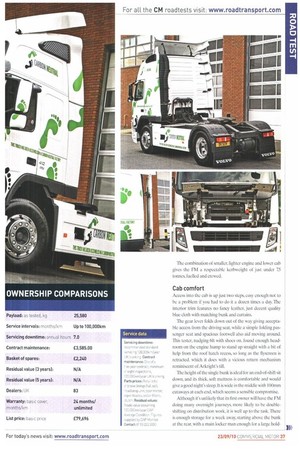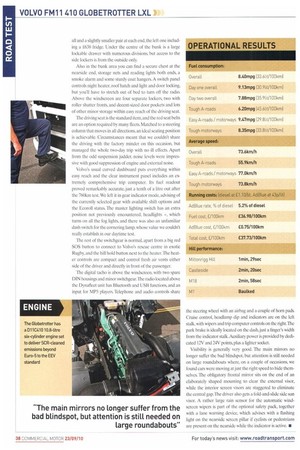2010 will go down in the annals of truck mad
Page 34

Page 36

Page 37

Page 38

If you've noticed an error in this article please click here to report it so we can fix it.
testing history as the year of the reality check. When the current inventory of press fleet trucks was ordered this time last year, with the European truck industry on the back foot, the green shoots of recovery were still struggling to find daylight and demonstrators needed to be relevant to volume sales. No more five-star gin palaces with Formula 1 power and so much torque that they need automatic clutches to avoid upsetting the earth's rotation. It is the sensible year.
And it doesn't get more sensible than this Volvo. A sensible low datum cab giving easy access, but sensibly specified with sleeper facilities to aid resale prospects, powered by a modestly rated engine promising sensible if not exhilarating performance. In fact, it is the archetypal supermarket trolley. There's just a bit of showcasing of selection of new tech from the options list to mark it out as a press fleet vehicle.
The Volvo in question is an FM11 4104x2,with its D11C410 10.8-litre six-cylinder engine set to deliver SCR cleaned emissions beyond Euro-5 to the EEV standard. the DC11 range runs through 330hp, 370hp and 410hp ratings to EEV, and extends to 450hp at Euro-5. Maximum power of the 410 tested is 405 true horsepower, produced between 1,600rpm and 1,900rpm, while torque is a 1,950Nm plateau between 950rpm and 1,400rpm, with the optimum economy 'green band' 1000rpin higher. Transmission is. of course, Volvo's lauded I-Shift automated unit, with 12 ratios and the fuel and economy software package, a worthwhile £926 option. Accommodation is courtesy of the LXL Globetrotter cab, combining a low floor with a high roof.
On the road Us road testers tend to be spoiled on occasions, and the thought of heading half the length of England and back with barely 400hp at our disposal fills us, if not with dread, then at least a little apprehension. The apprehension quota was raised when the initial proving ground track work revealed that less than 2,000Nm of torque was connected to the road via a 2.79:1 final drive more suited to line-haul operations in the deserts of Nevada. We hadn't reckoned on the intelligent management of the available power by the I-Shift transmksion and the little engine's sheer appetite for hard work.
That very tall gearing, with 80km/h equalling 1,100rpm in top, combined with the 410 marketing horsepower sees IShift drop to 11th when faced with any significant slope but, in most conditions, that's enough. On the first day up to Gretna, nothing lower was needed. As is our custom now, we left the automatics to their own decisions most of the time, but if your view of the road ahead makes it appropriate, it's easy to engage M and over-ride the computer with the handy toggle switch on the side of the gear lever.
When extra power is needed. the Power mode is engaged by a button behind the gear quadrant, with the transmission reverting to economy mode when it senses the need for power has passed. On the most severe climbs on the A68, we tend to allow auto mode to tackle Kiln Pit Hill, while taking manual control for the timed ascent of Castleside. The system works well enough to allow the three ratio block shift needed when the road rapidly heads towards vertical.
Despite the initial concerns, the on-road performance proved perfectly adequate despite the modest power-toweight ratio. It will never leave a trail of burning rubber, but we never really felt a desperate need for more power. Things might be different if you regularly operate in hilly terrain, and you'd certainly need to specify a shorter axle ratio, though. Sticking to the A-road limit on favourable terrain sees the FM chugging along quite happily at 950rpin in top.
The suspension tends to be too firm in some circumstances, with had motorway imperfections being experienced through the steering wheel. The cab, on the other hand, was quite soft, the degree of roll through tight bends being noticeable but a long way short of uncomfortable. As we'd expect from Volvo, the brakes were above reproach and likewise, the steering did its job without drama.The optional 4-stage VEB engine brake is highly effective, although we would still like a better detent so that we can return to Auto mode without worrying about not going straight to Off It would also be good if Volvo joined its Renault cousin and others in not disengaging the cruise control when you touch any brake control, whether service or engine, while checking an overspeed. More positively, we liked the + and — control on the end of the right-hand stalk, which allows adjustment of the overrun speed before the VEB engages. We experimented with the settings but found the default of 4km/h to work well.
Productivity
So popular has the 44-tonne 6x2 configuration become in the UK that this is only the ninth 40-tonne tractor to be tested by CM since 2002, and the third at Euro-5.This doesn't help to place the Volvo's performance in perspective, but we were slightly disappointed by the 8.40mpg overall figurc.The two previous Euro-5 candidates, a Mercedes-Benz Axor at 400hp and a 13-litre Volvo FM with 430hp managed 8.97mpg
and 8.60mpg respectively. Despite some rain on the first day, weather wasn't an issue and neither were road conditions. apart from being badly baulked up the timed hill south of Junction 23 on the Ml by a couple of abnormal loads.
Reluctant as we are to question the wisdom of Volvo's planners, we will anyway. We can't help feeling that while the ultra-high gearing is a benefit on easy motorways, it becomes a liability on tougher terrain, and could well be counter productive to overall economy. Comparing the individual figures with the most recent previous lap of the CM Scottish route, the 44-tonne Actros 460, the Volvo was better on most legs as you would expect. However, on the tough motorways section, on the hilly bits of Al, M18 and M18 in South Yorkshire and Nottinghamshire, the little FM was actually 0.2mpg worse. At 5.2%, the AdBlue consumption doesn't seem unduly affected by the extra-clean emissions.
Again as expected, the average speed figures were only significantly down on the tough A-roads section. The timed hill climbs, where economy takes a back seat, were actually very impressive, especially romping up Castlesidc in just two minutes, 20 seconds. The combination of smaller, lighter engine and lower cab gives the FM a respectable kerbweight of just under 15 tonnes, fuelled and crewed,
Cab comfort
Access into the cab is up just two steps, easy enough not to be a problem if you had to do it a dozen times a day. The interior trim features no fancy leather, just decent quality blue cloth with matching bunk and curtains The gear lever folds down out of the way giving acceptable access from the driving seat. while a simple folding passenger seat and spacious footwell also aid moving around. This tester, nudging 6ft with shoes on, found enough headroom on the engine hump to stand up straight with a bit of help from the roof hatch recess, so long as the flyscreen is retracted, which it does with a vicious return mechanism reminiscent of Arkright's till.
The height of the single bunk is ideal for an end-of-shift sit down, and its thick, soft mattress is comfortable and would give a good night's sleep. It is wide in the middle with lOOTnin cutaways at each end, which seems a sensible compromise.
Although it's unlikely that its first owner will have the FM doing many overnight journeys, more likely to be doubleshifting on distribution work, it is well up to the task. There is enough storage for a week away, starting above the bunk at the rear, with a main locker man enough for a large hold all and a slightly smaller pair at each end, the left one including a £638 fridge. Under the centre of the bunk is a large lockable drawer with numerous divisions, but access to the side lockers is from the outside only.
Also in the bunk area you can find a secure chest at the nearside end, storage nets and reading lights both ends, a smoke alarm and some sturdy coat hangers A switch panel controls night heater, roof hatch and light and door locking, but you'll have to stretch out of bed to turn off the radio. Above the windscreen are four separate lockers, two with roller shutter fronts, and decent-sized door pockets and lots of other minor storage within easy reach of the driving seat The driving seat is the standard item, arid the red seat belts are an option required by many fleets. Matched to a steering column that moves in all directions, an ideal seating position is achievable. Circumstances meant that we couldn't share the driving with the factory minder on this occasion, but managed the whole two-day trip with no ill effects Apart from the odd suspension judder, noise levels were impressive with good suppression of engine and external noise.
Volvo's usual curved dashboard puts everything within easy reach and the clear instrument panel includes an extremely comprehensive trip computer. Its fuel readout proved remarkably accurate, just a tenth of a litre out after the 760km test. We left it in gear indicator mode, advising of the currently selected gear with available shift options and the Ecoroll status. The master lighting switch has an extra position not previously encountered, headlights 4-, which turns on all the fog lights, and there was also an unfamiliar dash switch for the cornering lamp, whose value we couldn't really establish in our daytime test.
The rest of the switchgear is normal, apart from a big red SOS button to connect to Volvo's rescue centre in exotic Rugby, and the hill hold button next to the heater.The heater controls are compact and control fresh air vents either side of the driver and directly in front of the passenger.
The digital tacho is above the windscreen, with two spare DIN housings and minor switchgear.The radio located above the Dynafleet unit has Bluetooth and USB functions, and an input for MP3 players. Telephone and audio controls share the steering wheel with an airbag and a couple of horn pads Cruise control, headlamp dip and indicators are on the left stalk, with wipers and trip computer controls on the right. The park brake is ideally located on the dash, just a finger's width from the indicator stalk. Auxiliary power is provided by dedicated 12V and 24V points, plus a lighter socket Visibility is generally very good. The main mirrors no longer suffer the bad blindspot, but attention is still needed on large roundabouts where, on a couple of occasions, we found cars were moving at just the right speed to hide themselves. The obligatory frontal mirror sits on the end of an elaborately shaped mounting to clear the external visor, while the interior screen visors are staggered to eliminate the central gap.The driver also gets a fold-and-slide side sun visor. A rather large rain sensor for the automatic windscreen wipers is part of the optional safety pack, together with a lane warning device, which advises with a flashing light on the nearside screen pillar if cyclists or pedestrians are present on the nearside while the indicator is active. •
































































































































